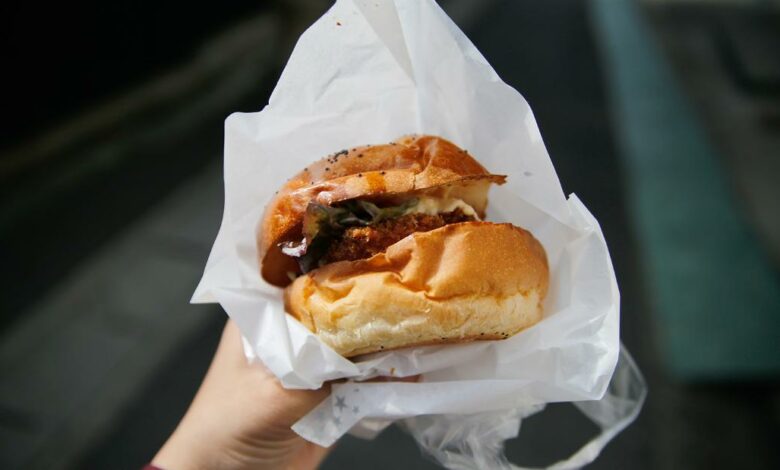
(CNN) – Alarming levels of dangerous chemicals known as PFAS were discovered in food packaging at a number of well-known fast-food and fast-casual restaurants and grocery store chains, a new report found.
The highest levels of indicators for PFAS were found in food packaging from Nathan’s Famous, Cava, Arby’s, Burger King, Chick-fil-A, Stop & Shop and Sweetgreen, according to an investigation released Thursday by Consumer Reports.
Often called “forever chemicals” because they do not break down in the environment, PFAS are used in food packaging to prevent grease and water from soaking through food wrappers and beverage cups. PFAS can also be found in the ink used to print logos and instructions on food containers.
The new report comes more than two years into the Covid-19 pandemic, when the public has relied heavily on takeout and grocery deliveries.
The US Centers for Disease Control and Prevention calls exposure to PFAS (per- and polyfluoroalkyl substances) a “public health concern,” citing studies that found the human-made chemicals can harm the immune system and reduce a person’s resistance to infectious diseases.
“There is evidence from human and animal studies that PFAS exposure may reduce antibody responses to vaccines,” stated the CDC and the Agency for Toxic Substances and Disease Registry. “More research is needed to understand how PFAS exposure may affect illness from COVID-19.”
More than 100 food products tested
The Consumer Reports investigation collected 118 food packaging products sold by 24 companies in the tristate area of New York, New Jersey and Connecticut. It tested those products for organic fluorine — a marker for PFAS. Researchers then sent samples of products with the highest levels to an independent laboratory that could perform more specific tests, said Michael Hansen, senior staff scientist for advocacy at Consumer Reports.
Regulatory limits for how much PFAS food packaging should contain can vary greatly. In the US, there are no federal limits, leaving action up to the states. Connecticut, Maine, Minnesota, New York, Vermont and Washington have passed bills banning intentional use of PFAS in food packaging, but haven’t yet specified a limit, according to Consumer Reports. In January 2023, a new law in California will set the limit at less than 100 ppm (parts per million).
However, Denmark set a much lower regulatory limit of 20 ppm with great success, said Xenia Trier, a chemicals, environment and human health expert at the European Environment Agency.
“In Denmark we’ve seen both a decrease in noncompliance by industry from 60% to about 30% and a decrease in levels of PFAS in packaging products over the past 10 years,” Trier told CNN. “It does work to set limits and enforce them. It is possible to find alternative solutions and if one manufacturer can make packaging without PFAS, then it should be possible for everybody to do it.”
The Consumer Reports investigation found the highest indicators for PFAS — 876 ppm and 618 ppm — in two types of bags for sides at Nathan’s Famous restaurants.
High indicators of PFAS (in the 500s) were also found in a Chick-fil-A sandwich wrapper and in fiber bowls at Cava, a Mediterranean restaurant chain.
Indicator levels in the 300s and 400s were found in a bag of cookies at Arby’s, bamboo paper plates at Stop & Shop, and in a bag for both cookies and French toast sticks at Burger King.
Levels of PFAS indicators in the 200s were found in a Sweetgreen paper bag for focaccia, additional items at Cava, and in bags for french fries, cookies and Chicken McNuggets at McDonald’s.
However, all of the companies listed had additional food packaging that tested at levels below 200 ppm. Four companies — Arby’s, Nathan’s Famous, McDonald’s and Stop & Shop — also sold food in packaging that had no detectable levels of PFAS, the report said.
The Consumer Reports investigation did not test packaging from every food product sold at each company.
“I would not urge consumers to take these brand names and only go to this one or that one, as this investigation only looked at just over 100 products,” said Graham Peaslee, a professor of physics, chemistry and biochemistry at the University of Notre Dame in Indiana.
“However, this will hold industry’s toes to the fire, so in that sense, I think it’s a valuable report,” he added.
“Measuring and saying PFAS is there and it’s dangerous gets people’s attention, and companies tend to avoid attention like that.”
Health impact of PFAS
PFAS chemicals are in many products: nonstick cookware, infection-resistant surgical gowns and drapes, cell phones, semiconductors, commercial aircraft and low-emission vehicles. The chemicals also are used to make carpeting, clothing, and furniture resistant to stains, water and grease damage.
In use since the 1950s, PFAS are chemicals most Americans have “in their blood,” especially perfluorooctane sulfonic acid (PFOS) and perfluorooctanoic acid (PFOA),” according to the Agency for Toxic Substances and Disease Registry, which is charged with protecting the public from hazardous substances.
In the Consumer Reports investigation, the most common chemical found in the food packaging that was tested was PFOA, with PFOS coming in fifth, according to the report.
In addition to impacts on the immune system, the Agency for Toxic Substances and Disease Registry said studies in humans and lab animals have found links between certain PFAS chemicals and an increase in cholesterol levels, alterations in liver enzymes, a higher risk of developing kidney or testicular cancer, small reductions in infant birth weights and an additional risk of high blood pressure in pregnant women.
“PFAS have also caused birth defects, delayed development, and newborn deaths in lab animals,” the agency stated, while adding “not all effects observed in animals may occur in humans.”
As environmental groups and the public began to take notice of the health impacts of the chemicals, manufacturers started to voluntarily phase out the use of PFOS and PFOA in the US. Between 1999 and 2014, blood levels of PFOS in Americans had declined by more than 80% and blood levels of PFOA had declined by more than 60%, the Agency for Toxic Substances and Disease Registry stated.
However, “as PFOS and PFOA are phased out and replaced, people may be exposed to other PFAS,” the agency continued. Newer versions of PFAS in food packaging appear to be absorbed by food more readily than the older versions, according to a 2016 study.
Studies in Denmark have shown that PFAS do “migrate from the paper into the food,” Trier said. “Even though it was not 100%, we still saw substantial transmission. In general, transmission from packaging to food is increased as the temperature of the food rises and the time spent in wrapping materials increases.”
Industry response
The Consumer Reports investigation mirrored results of reports in 2018 and 2020 by Toxic-Free Future and Safer Chemicals Healthy Families. Those reports found “harmful” levels of PFAS in fast-food packaging and in nearly two-thirds of takeout containers made of paper, like those used at self-serve salad buffets and hot bars.
In response to the 2018 report, Whole Foods became the first grocery chain in North America to publicly commit to remove PFAS from takeout containers and deli and bakery paper. Other companies have followed suit, including Ahold Delhaize, Albertsons, Amazon.com, Cava, Chipotle, Freshii, McDonald’s, Panera Bread, Sweetgreen, Trader Joe’s and Wendy’s, according to Toxic-Free Future.
In the new investigation, Consumer Reports tested 13 food packaging products from retailers that had previously committed to phasing out PFAS. Seven of the 13 had levels of PFAS above 20 ppm, the report said.
Burger King, which had high levels of PFAS in three of six products tested, had not made a public commitment to phase out PFAS, according to Consumer Reports. Early Thursday, parent company Restaurant Brands International announced it will globally phase out any “added” PFAS from “guest-facing packaging materials” at the Burger King, Tim Hortons and Popeyes brands “by the end of 2025 or sooner.”
Nathan’s Famous, which Consumer Reports said also has not made a public commitment to reducing PFAS, told CNN the company had begun phasing out the bags. “One of our goals in this complete package redesign is to reduce PFAS,” said Phil McCann, vice president of marketing at Nathan’s Famous. “Full transition will be complete by December 2022.”
Chick-fil-A told CNN it had been on a four-year journey to phase out PFAS: “Chick-fil-A has eliminated intentionally added PFAS from all newly produced packaging going forward in our supply chain. While some legacy packaging may still be in restaurants, it is expected to be phased out by the end of this summer,” the company tweeted Wednesday.
Cava, which had previously pledged to reduce PFAS but had five out of six products with indicators between 200 ppm and 548 ppm, told CNN that “due to a multitude of factors related to the pandemic, and especially global supply chain shortages, the transition to eliminating added PFAS, which began in August of 2021, is taking longer than planned. Our teams are working with our suppliers to complete the transition within the year.”
A McDonald’s spokesperson said less than 7.5% of the company’s global food packaging contained added PFAS at the end of 2020 and said the company was continuing its search for alternative materials that offered proper grease-resistant barriers, with a goal of reducing deliberately added PFAS by the end of 2025.
Sweetgreen told CNN the company was “proud to share that we are currently in the process of rolling out new PFAS-free focaccia bags that will be available in all Sweetgreen locations by the end of Q2.”
Jennifer Brogan, director of external communications and community relations for Stop & Shop, told CNN the company could “confirm that these Nature’s Promise brand plates have been removed from all store locations.”
A spokesperson from Arby’s told CNN in an email that the company has “minimal packaging materials containing PFAs and is on track to have PFAs removed from all packaging products by the end of 2022.”
Actions the public can take
Experts say people who want to avoid PFAS in their takeout and food delivery packaging should favor companies that have pledged to remove the chemicals.
Take food out of the container as soon as you receive it, and never reheat food in its original container. Instead, remove your food and heat it in ceramic or glass containers, Trier said.
The Consumer Reports investigation found some of the highest levels of PFAS were in paper bags (192.2 ppm) and molded fiber bowls and trays (156.8 ppm). Paper plates tested at 149 ppm, and food wrappers and liners came in at 59.2 ppm.
Don’t be fooled by “environmentally friendly” claims — they don’t guarantee a product is PFAS-free. When Consumer Reports tested those products, some had levels of PFAS above 100 ppm, and most had some detectable levels, the report said.




